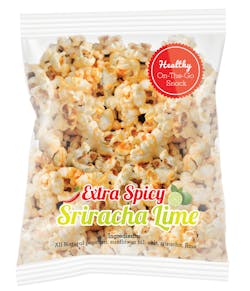These days, the food discussion seems to be centered around snacking. It’s not hard to see why. Nearly 94 percent of Americans snack at least once per day, while 50 percent snack two to three times per day, according to reports from Mintel. More frequent snacking is replacing standard meals for many and the definition of what makes a snack is changing, too.
Consumers are largely defining what they want in a snack and in all channels — vending and micro markets included — manufacturers are creating foods that fit those changing preferences.
“In the old days manufacturers would take a more random approach with new item introductions to see what would stick with consumers,” said Mark Dieffenbach, director, specialty channels, The Hershey Company. “Today, however, we [manufacturers] have consumer panels and have all put more research into what consumers are looking for in a snack.”
A sophisticated palate is drawing requests for both bold flavor combinations and a better-for-you angle in snacks. At the same time, consumers are opting for treats that are transparent — both in ingredients and packaging — as well as portable to fit with their on-the-go lifestyles.
Have fun with flavor
Twenty years ago, there were not as many flavor combinations in foods as there are today. Flavor profile is a large part of what consumers look for in snacks, and is one way operators can drive sales at the machine and micro market, says Kelly Fulford, General Mills Convenience, senior category development manager. “Bold flavors (e.g., sriracha, wasabi, chili lemon, seven layer dip) bring high taste and something new to traditional snacks,” she said. “New flavor combos and textures are ways to drive trial and keep consumers interested in what’s next. The trend of fusing sweet and savory together (e.g., pecan pie chips, chocolate and chili chips) to satisfy the desire for indulgence with a touch of saltiness is also growing.”
Why the reason for the increase in flavor-infused offerings? Simply put: data. “As manufacturers, we gather consumer feedback and take a strategic approach to matching consumer need states with what our other research and data is telling us,” said Dieffenbach. “When we identify a flavor or item to be trending we begin developing a product to fit that need.”
And what many have found is that food combinations and flavor pairings are the drivers in product development today. “Just as consumers seek more function in their snacks they have expanded their taste to support exotic flavor profiles,” said Earl Williams, Dole national sales manager-convenience business channels.
General Mills’ Fulford notes that from a bar category standpoint, although the category historically featured sweet flavor profiles like chocolate and fruit flavors, they’re now seeing bar innovations that feature savory and spicy flavors, oftentimes in tandem with sweet flavors.
But it’s not just the front label flavors consumers are looking at when choosing a snack. They are also paying closer attention to what’s going into their food and the way it’s presented in the package.
What’s inside matters
The better-for-you snack category has been steadily gaining traction for the last few years, but most manufacturers say that it’s still growing. And snacks now must do more than satiate — they must provide nutritional solutions, said Williams. “Natural snacks with healthy ingredients and clean nutritional panels are driving sales growth in the snack category,” he continued.
Eric Russell, Clif Bar & Company, director of sales, agrees. “Consumers want healthy, organic, sustainable food that is delicious, and immediately available to them — wherever they are and wherever they go.” Characteristics such as a limited number of ingredients, all natural, not fried, and real ingredients are popping up across all snack categories.
Micro markets give operators the opportunity to provide a wider variety of better-for-you options, too, says John Koskovich, marketing manager, Kar’s Nuts, makers of Second Nature Snacks. The company started placing its branded racks in markets, he said. “This allows for a bigger nut snack selection, which in turn lets the operator offer more healthy items.”
“Micro markets should ensure their assortment includes a variety of inherently healthy snacks to fuel shoppers’ on-the-go lifestyles during the day,” added Fulford. From a merchandising standpoint, she said, operators should try to group their better-for-you items together and leverage signage to make these items more visible on the shelf.
But it’s not all about micro markets. Manufacturers haven’t forgotten about vending. In fact, Dawn Cloutier, director of marketing innovation at PepsiCo Foodservice, notes that nearly 2/3 of consumers don’t use vending today because there aren’t healthier choices available. To counter that, the company came up with a way to embrace the better-for-you change and appeal to that consumer preference. “PepsiCo’s Hello Goodness machine combines our food and beverage portfolio to offer consumers a variety of healthier choices throughout the day,” said Cloutier. The machines carry everything from Quaker Breakfast Flats and Tropicana Pure Premium Orange juice to Aquafina, Baked Ruffles, Naked Juice and Sabra Hummus and Pretzels.
In addition to better-for-you ingredients, there continues to be a lot of innovation around clear packaging so consumers can see what they are purchasing and what appeals to their senses, says Fulford. “Bright colors and differential packaging are also emerging trends to help products jump out to consumers from the shelf.”
Bite-sized and portable is key
There continues to be a focus on making the snacking experience as convenient and “on-the go” as possible. Packaging innovations that meet that need include resealable bags, smaller “slam packs” and chip bags with horizontal openings to make it easy to grab chips and munch, says Fulford.
Dieffenbach agrees with these trends and notes that consumers are eating smaller, portion-controlled quantities, which has also led to more snacks becoming available in a ‘bite-sized’ option. He warns, however, that resealable packages might have unintended consequences for micro market operators. “If a consumer can close and save a snack for later, that diminishes the chance of them going back to the breakroom to make another purchase,” he said.
In an office setting, snacks are purchased with the intent that they will be eaten right away, so consumers are looking for items that are portable and single serve, says Patricia Dallas, brand manager — foodservice snacks, The Kraft Heinz Company. “Typically a vending/micro market consumer is seeking a snack to hold them over till their next meal,” she said.
The key is offering options that are full of flavor, transparent and movable with the consumer.
It’s about consumer experience
Vending and micro market operators can and should look at what items are selling at their locations. “Data insight is huge and can tell operators information specific to their customers, such a flavor and size preferences,” said Dieffenbach. “We are in the business of creating a consumer experience and that includes offering the items the customer wants to eat and drink,” he said. “You get this from your data.”
Operators can use data to not only tell them what new products are selling, but what core products are moving, too. Fulford notes that although innovation is important, operators don’t want to lose sight of the core SKUs that are continuing to drive sales and profits. “Leverage data to drive assortment decisions,” she said. “There are now so many data sources available from syndicated data to delivery data there is no reason not to make educated decisions about assortment. Partner with key manufacturers or your distributor to leverage key metrics and benchmark your performance to your competitive market.” She suggests that operators focus on categories that are driving sales and profits. “Evaluate and understand category, segment, brand and SKU level trends,” she continued. “Ensure you have your core SKUs represented and balance your assortment with new or regional items. It is also important to ensure you are allocating space correctly by performing a space to sales analysis against the segments represented across your key categories.”
Creating a consumer experience means more than offering new products, too. It includes a bigger picture. “In our industry operators should focus on breakroom design and features that draw consumers in,” continued Dieffenbach. This includes equipment with the latest technology such as bundled options, payment choices that fit what’s in the consumer’s pocket, a comfortable space where employees can interact and more.
The snacking experience has evolved in the 21st century and those operators who hope to grab the consumer’s attention and dollar need to focus on providing the items that fit their changing preferences.
Is the vending & retail consumer the same?
When a consumer enters a breakroom to purchase a snack, do they shop the same way they would at a grocery store? Mark Dieffenbach, director, specialty channels, The Hershey Company, points to brand A of soda. “If a consumer is loyal to brand A and enters a grocery store, they are going to purchase brand A,” he said. “When that same customer goes into a breakroom, they are going to look for their brand A soda. If it’s not there, research has shown that they will most likely bring it from home or get it somewhere else.” So yes, he says, the vending and retail consumer is the same shopper because they are brand loyal.
Kelly Fulford, General Mills Convenience, senior category development manager, has noticed a different trend. “The vending/micro market consumer is seeking immediate fulfillment (immediate consumption)/grab and go — versus the grocery trip which is to stock up,” she said. Micro market consumers, she says, are coming into the store to fulfill a need — which tends to be emotionally driven. “The micro market/vending trip also is more impulsive than the grocery trip — with over 60 percent of snack purchases driven by impulse versus grocery which is a planned trip.”
About the Author

Adrienne Klein
Contributing Editor
Adrienne Zimmer Klein is a freelance writer with a background in the vending, micro market and office coffee service industry. She worked as an associate editor and managing editor at Automatic Merchandiser and VendingMarketWatch.com from 2013 until 2017. She is a regular contributing writer at Automatic Merchandiser.
